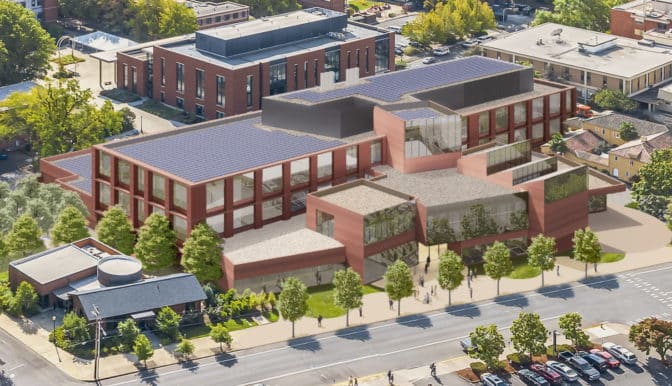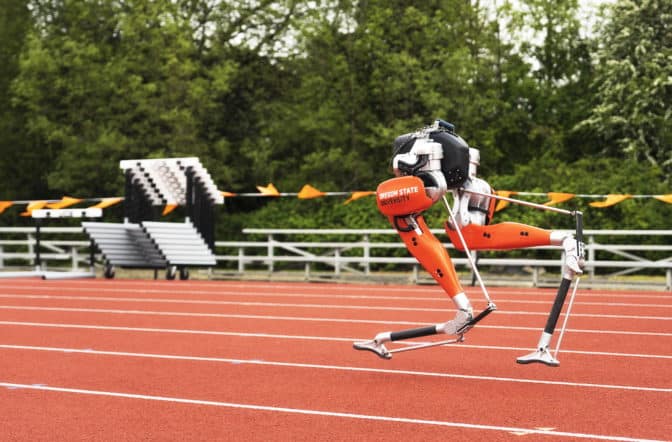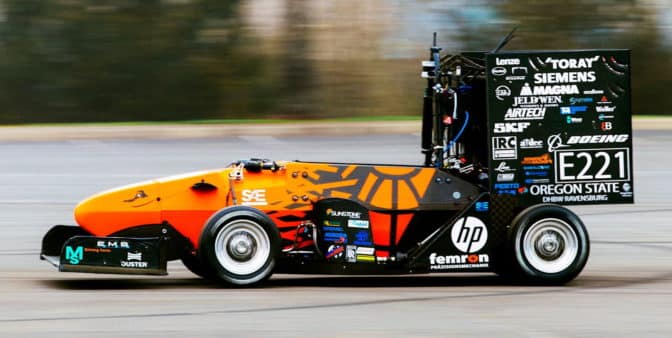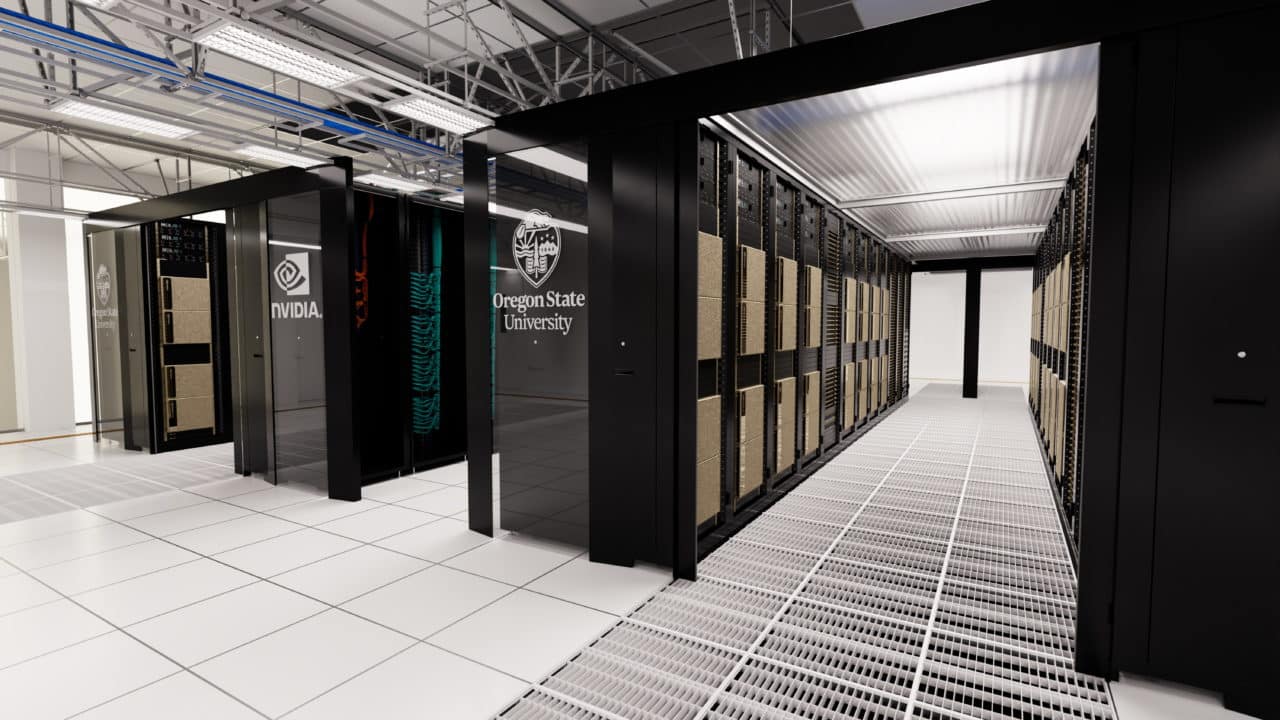As a civil engineer, Scott Ashford used explosives to make the ground under Japan’s Sendai airport safer in an earthquake. Now, as the dean of the engineering college at Oregon State University, he’s at ground zero of another seismic event.
In its biggest fundraising celebration in nearly a decade, Oregon State announced plans today for a $200 million center where faculty and students can plug into resources that will include one of the world’s fastest university supercomputers.
The 150,000-square-foot center, due to open in 2025, will accelerate work at Oregon State’s top-ranked programs in agriculture, computer sciences, climate science, forestry, oceanography, robotics, water resources, materials sciences and more with the help of AI.
A Beacon in AI, Robotics
In honor of a $50 million gift to the OSU Foundation from NVIDIA’s founder and CEO and his wife — who earned their engineering degrees at OSU and met in one of its labs — it will be named the Jen-Hsun and Lori Huang Collaborative Innovation Complex (CIC).
“The CIC and new supercomputer will help Oregon State be recognized as one of the world’s leading universities for AI, robotics and simulation,” said Ashford, whose engineering college includes more than 10,000 of OSU’s 35,000 students.
“We discovered our love for computer science and engineering at OSU,” said Jen-Hsun and Lori Huang. “We hope this gift will help inspire future generations of students also to fall in love with technology and its capacity to change the world.
“AI is the most transformative technology of our time,” they added. “To harness this force, engineering students need access to a supercomputer, a time machine, to accelerate their research. This new AI supercomputer will enable OSU students and researchers to make very important advances in climate science, oceanography, materials science, robotics and other fields.”
A Hub for Students
With an extended-reality theater, robotics and drone playground and a do-it-yourself maker space, the new complex is expected to attract students from across the university. “It has the potential to transform not only the college of engineering, but the entire university, and have a positive economic and environmental impact on the state and the nation,” Ashford said.
The three-story facility will include a clean room, as well as labs for materials scientists, environmental researchers and more.

Ashford expects that over the next decade the center will attract top researchers, as well as research projects potentially worth hundreds of millions of dollars.
“Our donors and university leaders are excited about investing in a collaborative, transdisciplinary approach to problem solving and discovery — it will revitalize our engineering triangle and be an amazing place to study and conduct research,” he said.
A Forest of Opportunities
He gave several examples of the center’s potential. Among them:
- Environmental and electronics researchers may collaborate to design and deploy sensors and use AI to analyze their data, finding where in the ocean or forest hard-to-track endangered species are breeding so their habitats can be protected.
- Students can use augmented reality to train in simulated clean rooms on techniques for making leading-edge chips. Federal and Oregon state officials aim to expand workforce development for the U.S. semiconductor industry, Ashford said.
- Robotics researchers could create lifelike simulations of their drones and robots to accelerate training and testing. (Cassie, a biped robot designed at OSU, just made Guinness World Records for the fastest 100-meter dash by a bot.)
- Students at OSU and its sister college in Germany, DHBW-Ravensburg, could use NVIDIA Omniverse — a platform for building and operating metaverse applications and connecting their 3D pipelines — to enhance design of their award-winning, autonomous, electric race cars.

Building AI Models, Digital Twins
Such efforts will be accelerated with NVIDIA AI and Omniverse, software that can expand the building’s physical labs with simulations and digital twins so every student can have a virtual workbench.
OSU will get state-of-the-art NVIDIA DGX SuperPOD and OVX SuperPOD clusters once the complex’s data center is ready. With an eye on energy efficiency, water that cooled computer racks will then help heat more than 500,000 square feet of campus buildings.
The SuperPOD will likely include a mix of about 60 DGX and OVX systems — powered by next-generation CPUs, GPUs and networking — creating a system powerful enough to train the largest AI models and perform complex digital twin simulations. Ashford notes OSU won a project working with the U.S. Department of Energy because its existing computer center has a handful of DGX systems.
Advancing Diversity, Inclusion
At the Oct. 14 OSU Foundation event announcing the naming of the new complex, Oregon State officials thanked donors and kicked off a university-wide fundraising campaign. OSU has requested support from the state of Oregon for construction of the building and seeks additional philanthropic investments to expand its research and support its hiring and diversity goals.
OSU’s president, Jayathi Murthy, said the complex provides an opportunity to advance diversity, equity and inclusion in the university’s STEM education and research. OSU’s engineering college is already among the top-ranked U.S. schools for tenured or tenure-track engineering faculty who are women.
AI Universities Sprout
Oregon State also is among a small but growing set of universities accelerating their journeys in AI and high performance computing.
A recent whitepaper described efforts at University of Florida to spread AI across its curriculum as part of a partnership with NVIDIA that enabled it to install HiPerGator, a DGX SuperPOD based on NVIDIA DGX A100 systems with NVIDIA A100 Tensor Core GPUs.
Following Florida’s example, Southern Methodist University announced last fall its plans to make the Dallas area a hub of AI development around its new DGX SuperPOD. And three years ago, the Milwaukee School of Engineering inaugurated Rosie, a supercomputer used to educate undergrads in the application of AI to solve real-world problems, with plans for a graduate certification program in the offing.
“We’re seeing a lot of interest in the idea of AI universities from Asia, Europe and across the U.S.,” said Cheryl Martin, who leads NVIDIA’s efforts in higher education research.

